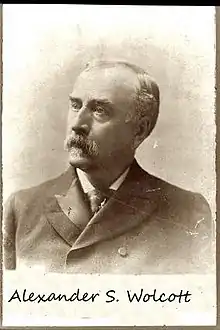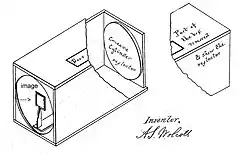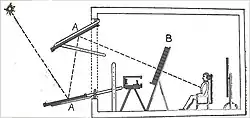Alexander S. Wolcott
Alexander Simon Wolcott (June 14, 1804 – November 10, 1844) was an American experimental photographer, inventor, and maker of medical supplies. With John Johnson, he created the world's first commercial photography portrait studio and patented the first U.S. camera that made photographs. The camera used a concave mirror to focus the available light onto a photosensitive plate less than a 1/2 inch (12.7 mm) square, that was eventually increased to 2 inches (50.8 mm) due to improved lighting techniques. The pictures on the plate were positive images and did not require reversion to correct. Wolcott opened various franchise photography studios as a business throughout the United States and England.
Alexander S. Wolcott | |
|---|---|
 circa 1843 | |
| Born | June 14, 1804 |
| Died | November 10, 1844 (aged 40) |
| Nationality | American |
| Occupation | Manufacturer |
| Known for | World's first portrait studio |
Notable work | First U.S. patented camera |
Early life
Wolcott was born on June 14, 1804, in New London, Connecticut.[1] He was the son of Alexander Wolcott Sr. and Joanne (née Paull) Wolcott. In his youth he was initially trained in the business selling merchandise in Connecticut but soon lost interest and decided to go into the field of dentistry.[3][4] He also at that time went into making optical instruments.[5]
Mid life
Wolcott moved to New York City in 1830 and made medical instruments and dental supplies for a living in the 1830s besides being a dentist.[6][7][8] He also worked as a machinist in the mechanics of designing and making instruments that used optics.[9][10][11] In 1839 he met John Johnson, a jeweler and watchmaker's assistant.[12] They established a business relationship with their trade skills and organized the firm 'Wolcott and Johnson' at 52 First Street in New York City.[5] The small business manufactured optical instruments and dental equipment.[13][14]
Camera development and career
Johnson learned about Louis Daguerre's photographic mechanics on how to make a camera soon after the details had arrived in America on September 20, 1839. Daguerre, an artist, had devised a month earlier in France a method of capturing a person's portrait onto a photosensitive metal plate by directing the light through a lens.[15] On October 6, 1839, Johnson took to Wolcott a copy of the specifications on Daguerre's method of capturing a likeness of a person and storing on a permanent plate that would hold the picture indefinitely.[16][17][18] They made a camera that day based on Daguerre's method and started experimenting with it.[1][19] Wolcott improved on Daguerre's lens camera by making a camera that used a concave mirror to gather more light instead of a simple refractive lens that gathered little light.[5][6][20] On October 7, 1839, Wolcott took a photograph of Johnson with his daguerreotype reflector camera,[21] creating the first photograph portrait in the world. [18][22][23]
Wolcott patented the camera on May 8, 1840 (US #1,582).[5][24][25] It became known as "Wolcott's camera" and the "mirror camera".[26] It was the first U.S. patent in photography.[28] Wolcott started selling his camera on March 4, 1840 in New York City at 52nd Street. He later moved to the Granite Building[19][29] on Broadway at the northwest corner of Chambers street.[30] The Daguerreian Parlor made commercial portraits in a photographic studio.[31][32][33] It was the world's first commercial daguerreotype gallery, a portrait photography studio.[19][34][35] The key innovation behind Wolcott's miniature pictures was his unique lightning system, which consisted of two adjustable mirrors outside that reflected sunlight through a trough consisting of glass bottles filled with a solution of copper sulfate producing a soft blue light that was more actinic so the sitter could endure the glare of bright sunlight.[23][30][31] The date marks the first time a newspaper advertisement (Sun Drawn Miniatures) was published for a camera taking of a professional picture and it cost $3 ($81.00 in 2021). By June, Wolcott had opened a branch in Washington D.C. which was operated by John G. Stevenson.[37][38] With his business partner John Johnson he operated studio franchises in England.[39]
Wolcott's camera used a polished concave mirror to reflect the focused light onto a photosensitive plate less than a 1/2 inch (12.7 mm) square. The pictures were not a negative image of reverse colors, but a correct positive image that did not require reversion of the image.[40] The size of the photosensitive plate was eventually increased to 2 inches (50.8 mm) by 2.5 inches (63.5 mm) that they could produce a likeness image as accurate as nature, because of their refined mechanical lighting techniques.[23] Wolcott with Johnson continued to improve their photography techniques. Wolcott made a photosensitive plate that used a chemical enhancer to develop the image.[41] It was a solution of bromide and chloride and known in London as the Wolcott's mixture.[9][42] This, along with highly polished silver plates, earned them a second U.S. patent in photography in December 1841, designated #2,391. They also designed outdoor mirrors that provided more light inside the studio for faster higher quality portrait pictures.[44]
 Wolcott reflector mirror camera diagram
Wolcott reflector mirror camera diagram
patent No. 1,582 Wolcott's box camera invention
Wolcott's box camera invention
patented May 8, 1840 Wolcott's system of illumination. A-A are the mirrors used to reflect a beam of light on the sitter. B is a trough of plate glass filled with a solution of blue vitriol to protect the eyes of the sitter.
Wolcott's system of illumination. A-A are the mirrors used to reflect a beam of light on the sitter. B is a trough of plate glass filled with a solution of blue vitriol to protect the eyes of the sitter.
Personal life and legacy
Wolcott married Mary Sanborn (born 1810 – unknown) and they had one child (Cynthia Louisa, born 1834 – unknown).[45] Wolcott died on November 10, 1844, at 40 years of age at his residence in Stamford, Connecticut.[1][40][46] There was a public auction held for the disposal of his personal property at the Store House of George E. Warring at the village of Stamford on December 10, 1844.[47] Alexander Street in Chicago, Illinois is named for him.[48]
The Centennial of Photography was celebrated in 1939 during which honors were paid to Louis Daguerre, the Frenchman who is acclaimed as one of the fathers of photography. At the time of celebration the MacMillan company of New York published a book titled Photography and American Scene — Social History 1839-1889 This reference book was the result of more than six years of research by Dr. Robert Taft, professor of chemistry at the University of Kansas. He dedicated the first two chapters of his book to the pioneer scientists of daguerreotype in the United States. They became interested in the new science soon after articles about Daguerre’s process had been reprinted from French and English journals in American newspapers from about March 1839. Taft made a statement in his book that D W Seager, an Englishman who was living in New York in 1839, was the first person to make a successful daguerreotype in the United States. Seager did this on September 27 1839. Dr. Taft gives the honor of the first successful portrait of a person to Wolcott who took a daguerreotype of his partner John Johnson on October 7 1839. He claims this is the first photographic portrait.[49]
Footnotes
- Falk 1999, p. 3116.
- Karad 2014, p. 49.
- Gillespie 2016, p. 13.
- Smith, Frank (1953). "Alexander S. Wolcott / America's First Photographic Genius". Signals. Armed Forces Communications Association. May–June: 18.
- KodakMuseum 1989, p. 21.
- McGraw-Hill 1969, pp. 136–137.
- "Making Culture Visible". Retrieved 22 January 2021.
- "Alexander S. Wolcott". Retrieved 22 January 2021.
- Newhall 1976, p. 156.
- Watson, Elmo Scott (June 13, 1940). "Again is Raised the Question of Who Made the First Camera in the U.S." The Times-Independent. Moab, Utah. p. 2 – via Newspapers.com
 .
. Wolcott who was an instrument maker and manufacturer of dental supplies took a daguerreotype of his partner John Johnson on October 7, 1839, according to Taft and this was the first photographic portrait.
- Gillespie 2016, p. 138.
- Welling, William (July 30, 1978). "Baltimore's Photo Pioneers". The Baltimore Sun. Baltimore, Maryland. p. 168 – via Newspapers.com
 .
. - Rinhart 1967, p. 4.
- "Your Photography". Lexington Leader. Lexington, Kentucky. August 20, 1939. p. 6 – via Newspapers.com
 .
. - APHA 1984, p. 54.
- Heathcote 2002, pp. 87–89.
- "Next Year will be celebrated the Centennial of Photography". Cambridge Clarion. Cambridge, Nebraska. November 24, 1938. p. 7 – via Newspapers.com
 .
. - Newhall 1976, p. 25.
- Gernsheim 1986, p. 19.
- "Alexander Wolcott". Eureka, a magazine for inventors. Vol. 1. New York City: Eureka. 1846. pp. 7, 23, 60, 69, 92.
- "Who made the first good daguerreotype!". Democrat and Chronicle. Rochester, New York. February 1, 1883. p. 2 – via Newspapers.com
 .
. - McDarrah 1999, p. 541.
- Macintosh 1843, pp. 275–283.
- Ikenson 2012, p. 4.
- Ikenson 2012, p. 15.
- "Patent issued". New Castle News. New Castle, Pennsylvania. June 8, 1978. p. 15 – via Newspapers.com
 .
. - Gillespie 2016, p. 139.
- Hirsch 2017, p. 32.
- Gernsheim 1986, p. 31.
- Glenner 1990, p. 11.
- Kane 1997, p. 414.
- Schimmelman 2002, p. 3.
- Daguerreian Society 2008, p. 105.
- Baird 1975, p. 1.
- Taft 1938, p. 460.
- "John Johnson 1813 - 1871". Science Museum Group collection. Science Museum Group UK. 2020. Retrieved October 12, 2020.
- "Mr. Alexander S. Wolcott". The Times-Picayune. New Orleans, Louisiana. November 20, 1844. p. 2 – via Newspapers.com
 .
. - "Alexander S. Wolcott". The Photographer's Friend. W. Newton. 3: 8. 1873.
- "Alexander S. Wolcott / America's First Photographic Genius". The London Journal of Arts, Sciences, and Manufactures, and Repertory of Patent Inventions. W. Newton. 25: 330–337. 1844.
- Weeden 2008, p. 39.
- Bohmer 1950, p. 232.
- "Died". The Manchester Times. Manchester, England. December 28, 1844. p. 5 – via Newspapers.com
 .
. - "Furniture etc at AUCTION". Stamford News. Stamford, Connecticut. December 17, 1844. p. 1.
- "Chicago Streets". Archdiocese of Chicago Archives. Archdiocese of Chicago. Retrieved 9 July 2021.
- Watson, Elmo Scott (June 13, 1940). "Again Is Raised the Question of Who Made the First Camera in the U.S. and Took the First Photographic Portrait (Released by Western Newspaper Union)". Brady Vindicator. Brady, Nebraska. p. 4 – via Newspapers.com
 .
.
Sources
- APHA (1984). Photographica Journal. American Photographic Historical Association.
- Baird, Joseph Armstrong (1975). Images of El Dorado.
- Bohmer, Rudd Alice (1950). Wolcott genealogy:the family of Henry Wolcott. OCLC 1152921168.
- Daguerreian Society (2008). The Daguerreian Annual. The Society.
- Falk, Peter H. (1999). Who was who in American Art. Sound View. ISBN 978-0-932087-55-3.
- Gernsheim, Helmut (1986). Concise History of Photography. Courier Corporation. ISBN 978-0-486-25128-8.
- Gillespie, Sarah Kate (12 February 2016). Early American Daguerreotype Cross Currents Art & Technology. MIT Press. ISBN 978-0-262-03410-4.
- Glenner, Richard A. (1990). The American dentist. Pictorial Histories. ISBN 978-0-929521-05-3.
- Hannavy, John (16 December 2013). Encyclopedia of Nineteenth-Century Photography. Routledge. ISBN 978-1-135-87327-1.
- Heathcote, Bernard & Pauline (2002). A faithful likeness. B. & P. Heathcote. ISBN 978-0-9541934-0-9.
- Hirsch, Robert (7 April 2017). Seizing the Light. Taylor & Francis. ISBN 978-1-317-37183-0.
- Ikenson, Ben (2012). Patents: Ingenious Inventions. Hachette. ISBN 978-1-60376-272-4.
- Kane, Joseph Nathan (1997). Famous first facts. H.W. Wilson. ISBN 978-0-8242-0930-8.
- Karad, Ashosk (2014). Clinical Orthodontics. Taylor & Francis. ISBN 9788131231685.
- KodakMuseum (June 1989). The Story of popular photography. Trafalgar Square. ISBN 978-0-943955-15-5.
- Macintosh (1843). Repertory of patent inventions. Macintosh.
- McDarrah, Gloria S. & Fred W. & Timothy S. (1999). The Photography Encyclopedia. Schirmer. ISBN 978-0-02-865025-8.
- McGraw-Hill (1969). Focal Encyclopedia of Photography. McGraw-Hill.
- Newhall, Beaumont (1976). The Daguerreotype in America. Courier Corporation. ISBN 978-0-486-23322-2.
- Rinhart, Floyd (1967). American Daguerreian Art. C. N. Potter. OCLC 1018400006.
- Schimmelman, Janice G. (2002). American Photographic Patents 1840–1880. Carl Mautz. ISBN 978-1-887694-21-6.
- Taft, Robert (1938). Photography and the American Scene. Acls History E Book Project. ISBN 9781597405867.
- Weeden, Brenda (2008). Education of the Eye. University of Westminster Press. ISBN 9781857570977.